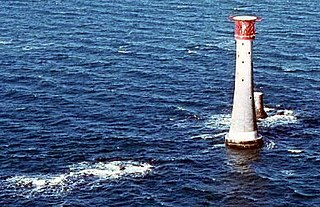
The Eddystone or Eddystone Rocks are a seaswept and eroded group of rocks ranging 9 miles (14 km) southwest of Rame Head in Cornwall, England, United Kingdom. Although the nearest point on the mainland to the Eddystone is in Cornwall, the rocks fall within the city limits of Plymouth, and hence within the county of Devon.
Bald sea urchin disease is a bacterial disease known to affect several species of sea urchins in the Mediterranean Sea, North Atlantic and along the California coastline. Research suggests two pathogens are responsible for the disease, Listonella anguillarum and Aeromonas salmonicida.
In biology, a species is often defined as the largest group of organisms in which any two individuals of the appropriate sexes or mating types can produce fertile offspring, typically by sexual reproduction. It is the basic unit of classification and a taxonomic rank of an organism, as well as a unit of biodiversity. Other ways of defining species include their karyotype, DNA sequence, morphology, behaviour, or ecological niche. In addition, paleontologists use the concept of the chronospecies since fossil reproduction cannot be examined.
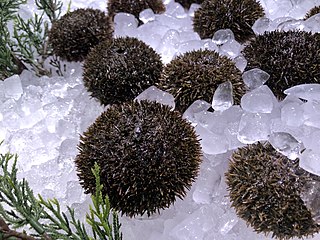
Hemicentrotus pulcherrimus is a species of sea urchin, the only one in the monotypic genus Hemicentrotus. It was first described by the American engineer and marine zoologist Alexander Agassiz in 1864 as Psammechinus pulcherrimus. Its range extends along the coasts of Korea and China, and in Japan from Kyūshū to Ishikari Bay. An edible species, it is harvested from Kyūshū to Fukui, in the Sea of Japan.

Novocrania anomala is a species of brachiopod found offshore in the eastern Atlantic Ocean.

Flustra foliacea is a species of bryozoans found in the northern Atlantic Ocean. It is a colonial animal that is frequently mistaken for a seaweed. Colonies begin as encrusting mats, and only produce loose fronds after their first year of growth. They may reach 20 cm (8 in) long, and smell like lemons. Its microscopic structure was examined by Robert Hooke and illustrated in his 1665 work Micrographia.

Psammechinus miliaris is a species of sea urchin in the family Parechinidae. It is sometimes known as the green sea urchin or shore sea urchin. It is found in shallow areas of the eastern Atlantic Ocean and the North Sea.
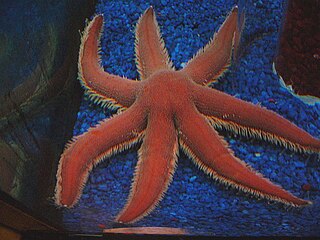
Luidia ciliaris, the seven-armed sea star, is a species of sea star (starfish) in the family Luidiidae. It is found in the eastern Atlantic Ocean and the Mediterranean Sea.

Ophiocomina nigra, commonly known as the black brittle star or black serpent star, is a species of marine invertebrate in the order Ophiurida. It occurs in the north-eastern Atlantic Ocean, the North Sea and the Mediterranean Sea.
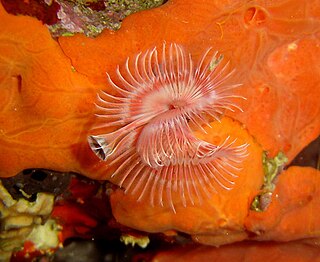
Serpula vermicularis, known by common names including the calcareous tubeworm, fan worm, plume worm or red tube worm, is a species of segmented marine polychaete worm in the family Serpulidae. It is the type species of the genus Serpula and was first described by Carl Linnaeus in his 1767 12th edition of Systema Naturae. It lives in a tube into which it can retract.

Psammechinus microtuberculatus, also known as the green sea urchin, in the family Parechinidae. It was formerly known as Echinus microtuberculatus, and thought to be of the genus Echinus.
Several species of sea urchin share the name green sea urchin:

Didemnum vexillum is a species of colonial tunicate in the family Didemnidae. It is commonly called sea vomit, marine vomit, pancake batter tunicate, or carpet sea squirt. It is thought to be native to Japan, but it has been reported as an invasive species in a number of places in Europe, North America and New Zealand. It is sometimes given the nickname "D. vex" because of the vexing way in which it dominates marine ecosystems when introduced into new locations, however the species epithet vexillum actually derives from the Latin word for flag, and the species was so named because of the way colonies' long tendrils appear to wave in the water like a flag.

Marthasterias is a genus of starfish in the family Asteriidae. It is monotypic and the only species in the genus is Marthasterias glacialis, commonly known as the spiny starfish. It is native to the eastern Atlantic Ocean.
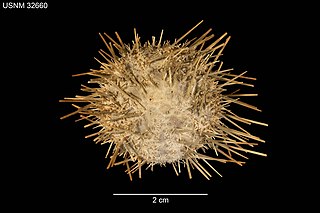
Lytechinus pictus, commonly known as the painted urchin, is a sea urchin in the family Toxopneustidae. It occurs on shallow reefs in the tropical and subtropical eastern Pacific Ocean, off the coasts of California, Central America and South America as far south as Ecuador.

Parechinus angulosus, the Cape urchin, is a sea urchin in the family Parechinidae endemic to southern Africa.
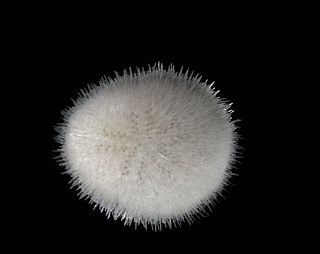
Echinocyamus pusillus, commonly known as the pea urchin or green urchin, is a species of sand dollar, a sea urchin in the family Fibulariidae, native to the northeastern Atlantic Ocean and the Mediterranean Sea. It buries itself in gravel or coarse sand at depths down to about 1,250 m (4,000 ft).

















